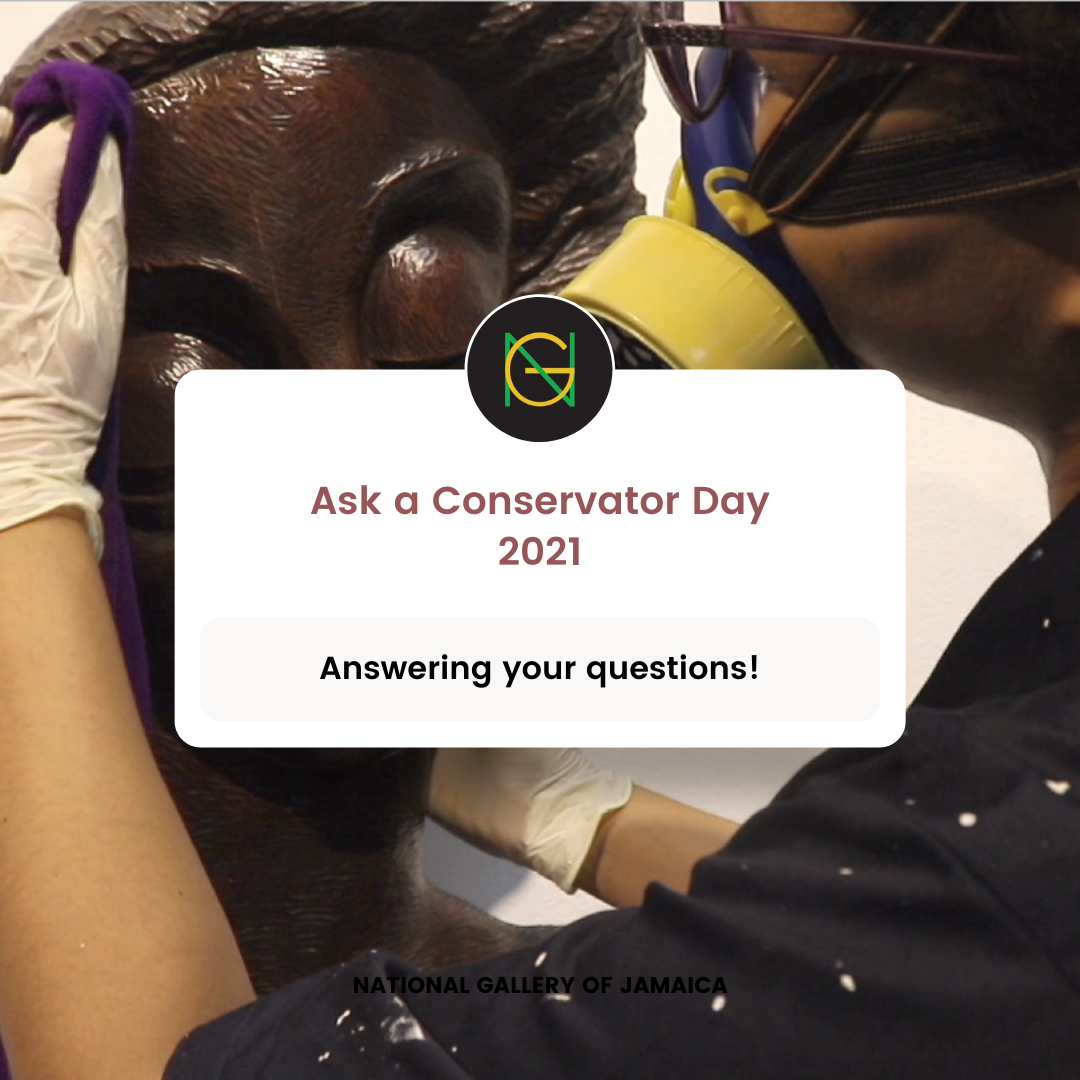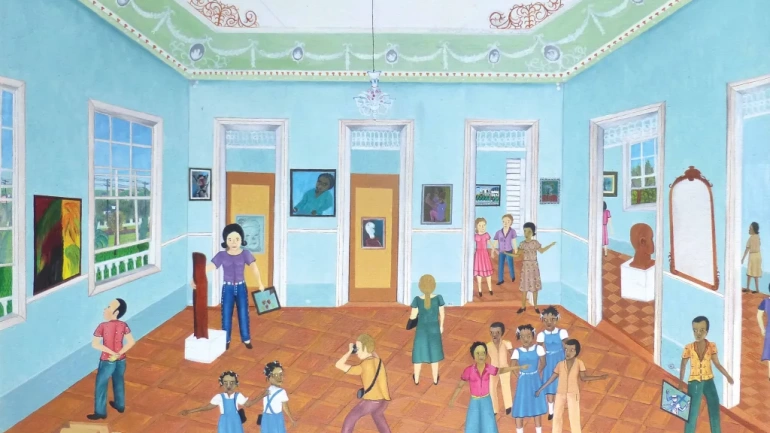The National Gallery of Jamaica participated in our second #askaconservatorday on November 4, 2021. This annual international event was created to highlight the conservation practice and give the public an opportunity to ask questions and learn more about the profession’s contribution to cultural heritage management.
Invitations to send in questions were posted on the NGJ’s social media platforms before the event and viewers were encouraged to ask questions during the live recording. Below are some of the questions the public asked for #Askaconservatorday answered by our conservator Ms. Joelle Salkey.
How does art conservation work?
Art conservation works through a series of deliberate actions aimed at ensuring the safety and longevity of art. These actions can be viewed in a scientific/ academic capacity or they can be as uncomplicated as good housekeeping. Once a conscious decision has been made to protect art and its surrounding environment, it’s considered a part of the conservation practice.
Who handles art conservation?
Art conservators are trained heritage professionals. They are really the only ones who should be executing art conservation techniques.
What does the process involve?
Conservation incorporates a myriad of processes all executed with the end goal of preserving (to the best of our capability) the overall integrity of the art object. Some of these processes involve: observation, assessment and evaluation, research, testing/sampling, execution of treatment, monitoring and maintenance.
When would a piece of art need to be conserved?
Once the artwork has been created and exists in a physical space it’s technically begun it’s conservation treatment. The safety and preservation of the artwork tends to be a continuous process and as menial as it may seem is a big part of the conservation process. Actual interventive or remedial conservation should only be carried out if the artwork shows obvious signs of deterioration and is in need of stabilization and restoration.
Does the gallery engage in conservation?
Yes, but only on works in the National Collection and that is conditionally based on the availability of resources at our disposal.
Are there a lot of conservators in the Caribbean?
Unfortunately, there are not enough conservators in the Caribbean. While I’m not certain of the exact number; in Jamaica I’m aware of 5 trained conservation professionals – myself included.
How long does it take to become a conservator?
It depends heavily on how far you are willing to pursue the profession and your background. Having a background in Art History, Art making and Chemistry is always an asset and will guarantee a smoother entry into the profession. Technically, a tertiary education in conservation can take you anywhere from 4 to 10 years depending on your areas of specialty and your academic aspirations.
Why did you choose conservation as your specialty?
I, personally, have always had a love for art and art making. I love visiting museums and seeing art and artefacts made hundreds of years ago. When I realized a profession enabled me to merge my love for art and art history, as well as allowed me to physically touch these treasures, I jumped at the opportunity to become a conservator.
Are there ever pieces that you just can’t save? Give Examples.
Unfortunately, yes. On occasion conservators come across artworks or artefacts that have been so heavily damaged (whether by fire, pests, neglect or any extreme variation of the agents of deterioration) that our actions will have little to no beneficial effect. In these cases, we can document the current state of the piece and develop a maintenance plan for the remains (as we recognize that, even destroyed, it may contain valuable information to a researcher one day). There are one or two works in the collection that exist as fragments (not caused by malicious intent, sometimes simply age and degradation of materials are a factor) but they are kept for posterity and still hold value to the national discussion on art.
How would you conserve digital pieces? As you only deal with physical artworks.
Conservation is primarily concerned with the preservation of the original object’s tangible culture, meaning things that have a physical form. Digital art presents several challenges to the profession as in addition to lacking a physical form, there is the issue of originality. A file, once saved, exists as a copy or version of the original. Once transferred to another medium – whether by SD card or flash drive or cloud storage or even printed on a physical support – it is still recognized as a copy as multiple versions of the same file exist. If a printed poster is damaged by fire for example, the creator can simply print a new copy using the original file. There is practically nothing a conservator can do, outside of contacting a computer professional if the original file is lost or corrupted. By comparison, if a physical object is damaged by fire – not only can that damage be considered vital to the objects’ history (eg. The melted bottles of Hiroshima – which are significant because they show the damage caused by an atomic bomb), if minimal some of the aesthetical damage can be minimized through restoration. The damage should still be recorded as it will always represent a part of the object’s history and conservation treatment.
The conservation of intangible art is becoming a popular topic in modern conservation. With the rise of NFT’s and the popularity of digital art and social media platforms, we could look out for digital conservation professionals in the future.
What is the cost of conservation?
This depends on a variety of factors. If trying to establish a financial cost – it is dependent on the type of object, the age of the object, the value of the object, the composition of the object, the type of damage and the availability of resources necessary to stabilize and restore the object, and the time and expertise necessary to conserve the object. There’s no flat fee.
A seemingly simple restoration procedure can run into the hundreds of thousands based on other factors not listed above.
How much do you get paid to restore damaged artwork?
As mentioned above, a variety of factors can affect the cost of conservation and therefore the amount a conservator may charge.
What is the most difficult part of conserving paintings?
The preparatory work leading up to the treatment, including research and securing the relevant permissions to conduct a treatment. The amount of paperwork necessary to perform an ethical conservation exercise is very tedious. The treatment is the fun part.
Is it always necessary to remove varnish from a painting during treatment?
No. It is not always necessary to remove varnish from a painting to execute a treatment. This is heavily dependent on the use of the object and the extent of damage to the object. If the damage is minimal, some restoration can be done without removing the varnish layer. Varnish removal is extremely detrimental to the artwork and should be minimized where possible due to the use of harsh solvents.
What do you do if a painting is flaking?
Lie the painting flat, face up and take photographs of the areas of damage. Then call a conservation professional.
What does “re-touching” mean?
“Re-touching” and another term “in-painting” are used to describe the restoration process of matching a pigment or design on an artwork or artefact. This “re-touching” is done to enhance the aesthetic qualities of the object which can lead to its overall appreciation as a seemingly complete object rather than bring focus to the areas of damage.
What’s the oldest artwork you’ve worked on?
To date, about 1000 years old – mechanical cleaning of a Taino Duho.
How do I know a conservator is qualified before I have them work on a piece?
This is quite a complicated question. There’s currently no existing framework of accreditation in the Caribbean that can assist with identifying a verified conservator. In the Jamaican context, our conservators have tertiary accreditation in Chemistry and or Art making or Conservation and have contributed to conservation awareness through teaching, workshops and articles. They also have years of verified experience in their chosen fields and follow an international code of ethics (ICOM) that is based on ensuring the inherent safety of the artworks in need of conservation above all else. Before you employ a conservator, you can ask about their training, their level of experience, area of specialty, and years in practice. You could also ask to see their portfolio and for verified references who could recommend their work.
Will artists ever work with you on a treatment?
Occasionally, yes. The artist often supplies us information on the composition of the artwork which is beneficial to the long-term preservation and treatment of the object.
Are there many job opportunities as a conservator?
Unfortunately, because the profession is not well known in our region, it’s a little difficult to speak about the opportunities available. Internationally, conservation is a long-serving profession that once entered people tend to stay in the job position until retirement or longer. This tendency to be “long-serving” does tend to have an impact on job availability. There are greater opportunities internationally, but over time we hope to have increased awareness of the profession that leads to more full-time job opportunities.
How does one become a conservator?
You can become a conservator by entering a conservation program at a recognized institution or university at the undergraduate, graduate or even postgraduate level. A beneficial asset is a background in any of three core subjects: Chemistry, Art History or Art practice.
What do you love about your job as a conservator?
Personally, I truly enjoy being around and physically interacting with objects of heritage and art. I have a fascination about very old objects and I enjoy preserving these historical markers for future researchers and members of the public to enjoy. I really enjoy being a part of the reason these objects “survive time” and the fact that conservation grants me the opportunity is a blessing.
Are there any training programmes for conservation in Jamaica?
There are, though they are very rare. We encourage you to follow our social media pages as well as the social media pages of our National Museums Jamaica, the Institute of Jamaica as well as the Jamaica National Heritage Trust to see when announcements are sent out.
I hope I was able to answer your questions with clarity and if there are more please don’t hesitate to leave them in the comments below.
Thank you for participating in this years #AskaConservatorDay exercise. And thank you for your interest in conservation!



